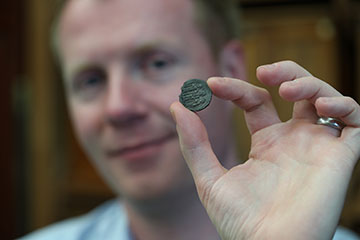
Rory Naismith, University of Cambridge, holds a Byzantine silver coin in the Fitzwilliam Museum at Cambridge. [Image: Adam Page]
Archaeologists had long wondered why people in Anglo-Saxon England had started using many more silver and fewer gold coins between 660 and 750 CE. Now researchers in Europe say they have developed a method to help find the answer (Antiquity, doi:10.15184/aqy.2024.33). The technique combines laser ablation with traditional trace-element analysis to match the isotopic abundances of the silver bullion in the coins with known sources of metal ores from the period.
Isotope ratios in historical coins
While previous generations of archaeologists classified coins and other artifacts by their shapes, inscriptions and other easily viewed details, today’s researchers probe these objects at the atomic level.
A team from the universities of Oxford and Cambridge, UK, and Vrije Universiteit Amsterdam (VU), Netherlands, selected 49 coins from the collections of Cambridge’s Fitzwilliam Museum. The coins were found in regions bordering the North Sea known as Anglo-Saxon England, Frisia and Francia. All were previously dated from approximately 670 to 816 CE, an era that historians sometimes call the “long eighth century.” The group members were looking for lead isotope ratios and concentrations of gold, bismuth and other trace elements in the silver, both for clues to the silver’s origins and for details about medieval refining and smelting processes.
Leveraging laser ablation
First, the researchers subjected the coins to a laboratory-based system called laser ablation inductively coupled mass spectrometry (LA-ICPMS) at the University of Cambridge. The team ablated each coin for 60 s using laser energy of 6 J/cm2 with 10 Hz pulses and quantified the presence of 18 isotopes including silver, gold, chromium and zinc.
Next, the group took a portable laser ablation system, recently developed at VU, into the Fitzwilliam Museum to measure the lead isotopes in the coinage. The device consisted of a 532-nm-wavelength pulsed diode-pumped solid-state laser connected to an optical fiber and then to a 100-μm-wide aspheric lens focusing the beam on each coin. Teflon filters collected microscopic amounts of the ablated material, which the team then analyzed with mass spectrometry.

A selection of the Fitzwilliam Museum coins that were studied, including coins of Charlemagne (748–814 CE) and Offa of Mercia (died 796 CE). [Image: © Fitzwilliam Museum, University of Cambridge]
Jane Kershaw, University of Oxford, says that typical laser ablation setups are about 10 times less accurate than taking a physical sample, dissolving it with wet chemistry and running it through a lab-based mass spectrometer. However, archaeologists want the highest level of accuracy with as little damage to precious historical artifacts as possible.
That’s why the portable laser ablation system and its Teflon filter delighted the archaeologists. “This way, we get minimally invasive sampling with high-precision results (equivalent to wet chemistry),” Kershaw says. “Plus, there is no chamber, so we are not restricted in the size of object we can analyze. This is a very new technique that has been applied to pigments in museum art pieces, but which we have pioneered on archaeological silver. There are only a few portable lasers around. You can't buy these machines, you have to build them, and we were fortunate to use the machine built at the Vrije University Amsterdam.”
Origins of the silver
The team found that the 29 earliest coins―those dated before 750 CE―had an isotopic signature matching silver mined in the Byzantine Empire in the third to seventh centuries CE. The later silver coins contained low levels of gold, characteristic of silver mined in Melle, a location in modern-day western France.
“Nothing else in the archaeological record would lead us to believe that Byzantine silver was present in England in such quantities that it could be a source of silver for the first post-Roman silver coins,” Kershaw says. “The idea that the eastern Mediterranean fueled the resurgence of the economy in northwest Europe is quite astounding. The results for the later coins (post-750 CE) were more in line with what we were thinking. Nonetheless, it emphasizes how dependent England was on silver from the Continent.”
Kershaw has been studying medieval silver for the past five years. “We've used laser methods and direct physical sampling, always using a combination of lead isotope and trace element data (gold and bismuth are especially important),” she says. “In the past, people have worried that the mixing and refining (cupelling) of silver made interpreting results difficult, if not impossible. But we've been able to draw conclusions for Islamic silver, Viking silver and now Anglo-Saxon silver. We can model mixing, and refining turns out not to be that common. The methods are powerful―the paradigm works!”
